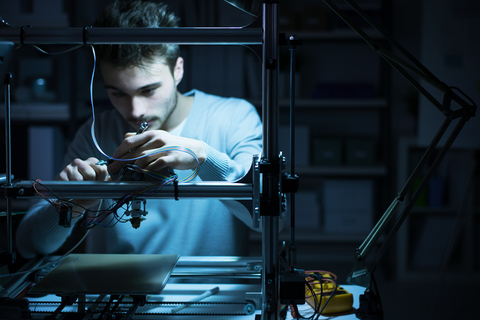Surgeons use 3D printed implant to rebuild chest wall

Peter Maggs, a seventy old year old grandfather from Abergavenny, has become the first person in Wales to have his chest wall rebuilt with a 3D printed prosthesis following the removal of a large tumour.
Abertawe Bro Morgannwg University Health Board reports Peter Maggs had three ribs and half his breastbone removed during the day long operation at Morriston Hospital in Swansea, carried out by consultant surgeons Ira Goldsmith and Thomas Bragg, with the support of the Morriston surgical team.
The tumour had grown to around the width of a tennis ball. Ira Goldsmith said “It was a very extensive growth that needed to be removed. However, removing it also meant removing part of the breastbone and three ribs. That would leave a large defect that could have destabilised the entire chest wall and reconstructing it was going to be a very complex procedure. Traditionally the operation would have used a cement prosthesis, prepared at the time of surgery. Although it can be fairly substantial it is not a precise fit, and it can move, causing problems such as dislocation.”
A cement prosthesis would have taken around an hour and a half to prepare. As Peter Maggs has heart and other health issues the surgeons were keen to reduce the operating time as much as possible. So the decision was made to use a titanium implant, which was based on Ira Goldsmith’s own design and manufactured ahead of surgery.
Using Peter Maggs’ CT scans, Morriston’s biomedical 3D technician Heather Goodrum and maxillofacial laboratory services manager Peter Llewelyn Evans created the bespoke implant. It was 3D printed in titanium by technology company Renishaw, one of the partners in a collaborative innovation project with Morriston Hospital. This was the first time such an implant has been printed in the UK.
The surgery was carried out and Ira Goldsmith said the prosthesis fitted into place perfectly. It was originally supposed to have been screwed in. But as the bone was narrow and soft there was a chance it could break so Ira Goldsmith sewed it into place instead. The implant was then covered with a section of latissimus dorsi muscle, which plastic and sarcoma surgeon Thomas Bragg had earlier harvested from Peter Maggs’ upper back, and the wound was closed. The entire procedure took eight hours, around two hours quicker than if a cement prosthesis had been used.
Ira Goldsmith said “We are very pleased with the outcome. The implant is a perfect fit. Titanium is very strong and any problems like dislocation are reduced or even eliminated because the implant is anchored securely to the ribs and breastbone…It was the first time for this procedure to be carried out in Wales and because of its success we plan to carry it out again in the future. We have also liaised with Swansea University and together we are drawing up protocols enabling other surgeons around the world to learn from us so they can use this technique on their own patients.”
Ira Goldsmith will give a presentation at the British Sarcoma Group meeting in Birmingham later this month, and at the Society for Cardiothoracic Surgery in Great Britain and Ireland annual meeting in Glasgow next month.








